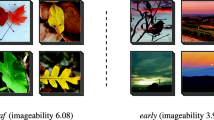Abstract
Personalising web search engines, a crucial issue nowadays, would obviously benefit from the system's ability to capture such an important aspect of a user's personality as visual impressions and their communication. Unfortunately, such impressions are intrinsically variable and very difficult to make explicit. In this paper, we propose a methodology to dynamically create personalised models of visual impression words. We suggest that it can be achieved by exploiting multimedia data mining on the large amount of information contained in an image and in its mapping onto an impression word. The continuous adaptation of each model utilises not only relevance feedback but also externalisation feedback. The externalisation process, triggered by the data mining activity, is supported by a conceptual space whose tools allow users to transform their mental model into formal specifications. For experimental validation purposes, a web-based meta search engine has been developed that can retrieve images on the basis of impression words.
Similar content being viewed by others
Explore related subjects
Discover the latest articles, news and stories from top researchers in related subjects.References
Bianchi-Berthouze, N. and Berthouze, L. (2001). Exploring Kansei in Multimedia Information. International Journal on Kansei Engineering, 2(1), 1–10.
Bianchi-Berthouze, N. and Lisetti, C. (2002). Modeling Multimodal Expression of Users's Affective Subjective Experience. International Journal on User Modeling and User-Adapted Interaction, 12(1), 49–84. Special Issue on User Modeling and Adaptation in Affective Computing, Fiorella De Rosis (Ed.).
Bianchi, N., Bottoni, P., Mussio, P., Rezzonico, G., and Strepparava, M.G. (1997). Participatory Interface Design: From Nave Models to Systems. In Proceedings of International Conference on Human Computer Interaction (pp. 24–29).
Gardenfors, P. (2000). Conceptual Spaces: The Geometry of Thought. Cambridge, MA: MIT Press.
Gopnik, A., Glymour, C., and Sobel, D. (1999). Casual Mas and Bayes Nets: A Cognitive and Computational Account of Theory Formation. In International Congress on Logic, Methodology and Philosophy of Science.
Han, J. and Kamber, M. (2001). Data Mining: Concepts and Techniques. Academic Press.
Hattori, R., Fujiyoshi, M., and Iida, M. (1999). An Education System on WWW for Study Color Impression of Art Paintings Applied NetCatalog. In Proceedings of IEEE International Conference on Systems Man and Cybernetics, Vol. 6 (pp. 218–223).
Inder, R., Bianchi-Berthouze, N., and Kato, T. (1999). K-DIME: A Software Framework for Kansei Filtering of Internet Material. In Proceedings of IEEE International Conference on Systems Man and Cybernetics, Vol. 6 (pp. 358–363).
Isomoto, Y., Yoshine, K., Yamasahi, H., and Ishi, N. (1999). Color, Shape and Impression Keywords as Attributes of Painting for Information Retrieval. In Proceedings of IEEE International Conference on Systems Man and Cybernetics, Vol. 6 (pp. 257–262).
Kitajima, M. and Don-Han, K. (1998). Communicating Kansei Design Concept via Artifacts: A Cognitive Scientific Approach. In Proceedings of the International Workshop on Robot and Human Communication (pp. 321–326). IEEE Press.
Kobayashi, H. (2000). The Semantic Network of KanseiWords. In Proceedings of IEEE International Conference on Systems Man and Cybernetics (pp. 690–694).
Kobayashi, S. (1998). Colorist: A Practical Handbook for Personal and Professional Use. Kodansha Press.
Miyake, N. (1997). Making Internal Process External for Constructive Collaboration. In J. Marsh, C. Nehaniv, and B. Gorayska, (Eds.), Proceedings of International Conference on Cognitive Technology (pp. 119–123). IEEE Computer Society.
Munsell, A.H. (1905). A Color Notation. Boston.
Nakata, T., Sato, T., and Mori T. (1998). Expression of Emotion and Intention by Robot Body Movement. In Proceedings of the International Conference on Autonomous Systems, 5 (IAS-5).
Pashler, H. (1996). Attention and Visual Perception: Analysing Divided Attention. International Journal of Visual Cognition, 2, 71–100. S.M. Kosslyn and D.N. Osherson (Eds.).
Rui, Y., Huang, T.S., Ortega, M., and Mehrotra, S. (1998). Relevance Feeback: A Power Tool in Interactive Content-Based Image Retrieval. IEEE Transaction on Circuits and Systems for Video Technology, 8(5), 644–655.
Shibata, T. and Kato, T. (1999). Kansei Image Retrieval System for Street Landscape: Discrimination and Graphical Parameters Based on Correlation of Two Images. In Proceedings of IEEE International Conference on Systems Man and Cybernetics, Vol. 6 (pp. 247–252).
Tolman, E. (1948). Cognitive Maps in Rats and Men. Psychological Review, 55,189–208.
Vailaya, A., Figueiredo, M.A.T., Jain, A.K., and Zhang, H.J. (2001). Image Classification for Content-Based Indexing. IEEE Transaction on Image Processing, 10(1),117–130.
Vendrig, J., Worring, M., and Smeulders, W.M. (2001). Filter Image Browsing: Interactive Image Retrieval by Using Database Overwiews. International Journal on Multimedia, Tools and Applications, 15(1), 83–103.
Zaiane, O.R, Han, J., Ze-Nian, L., Chee, S.H., and Chang, J.Y. (1998). MultiMediaMiner: A System Prototype for Multimedia Data Mining. In Proceedings of International ACM-SIGMOD Conference on Data Management.
Zhang, J., Hsu, W., and Lee, M.L. (2001). Image Mining: Issue, Frameworks and Techniques. In Proceedings of International Workshop on Multimedia Data Mining (MDM/KDD), San Francisco (USA) (pp. 13–20).
Author information
Authors and Affiliations
Rights and permissions
About this article
Cite this article
Bianchi-Berthouze, N. Mining Multimedia Subjective Feedback. Journal of Intelligent Information Systems 19, 43–59 (2002). https://doi.org/10.1023/A:1015512403706
Issue Date:
DOI: https://doi.org/10.1023/A:1015512403706




